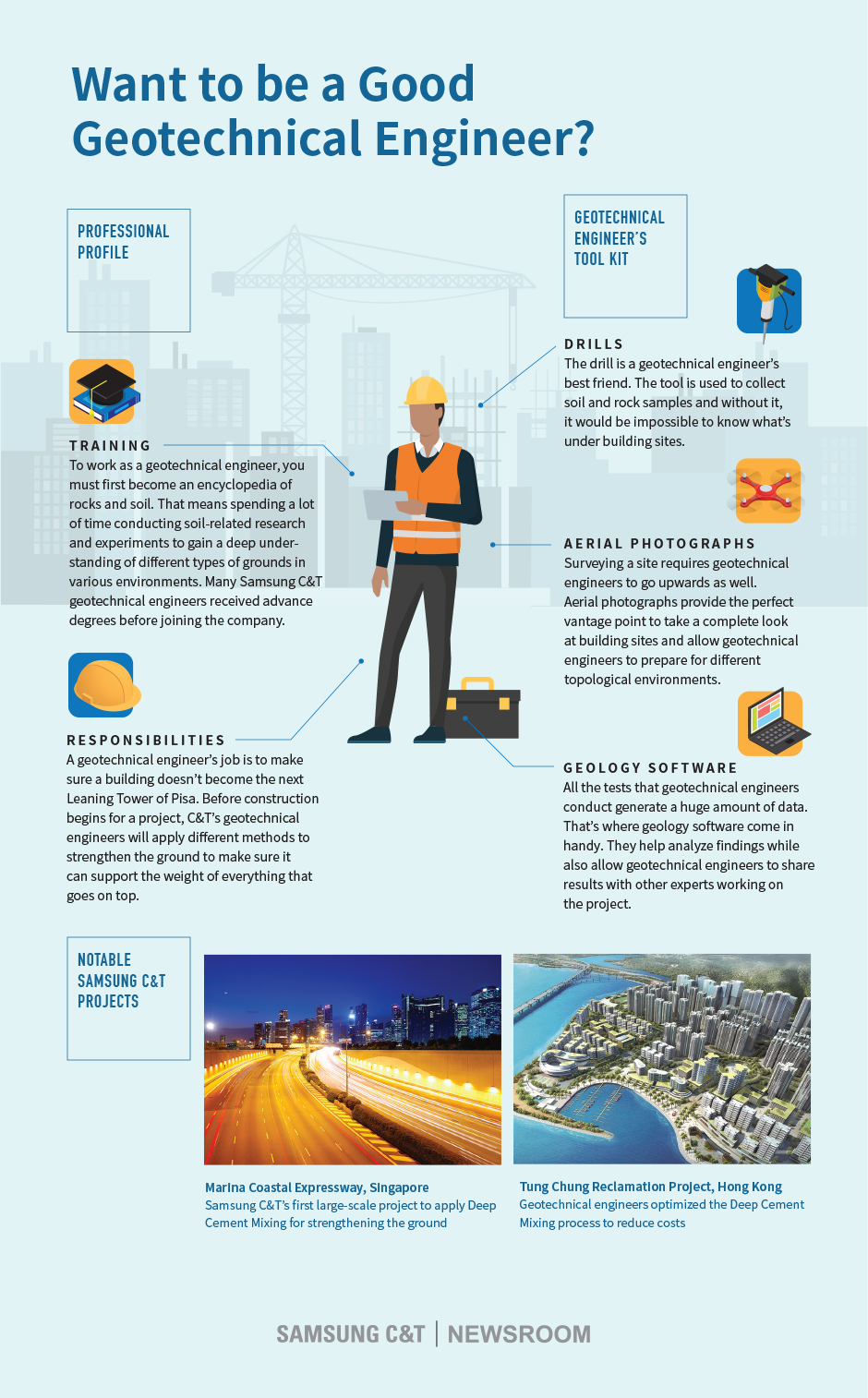The Definitive Guide to Geotheta
The Definitive Guide to Geotheta
Blog Article
The Only Guide to Geotheta
Table of ContentsThe Basic Principles Of Geotheta Geotheta Fundamentals ExplainedNot known Incorrect Statements About Geotheta Little Known Questions About Geotheta.Rumored Buzz on Geotheta

They perform site examinations, collect samples, carry out lab tests, and evaluate data to examine the viability of the ground for building and construction tasks - Consulting Engineer. Based on their searchings for, geotechnical engineers provide recommendations for foundation layout, incline stability, keeping frameworks, and mitigation of geotechnical hazards. They work together with other professionals, such as architects, architectural designers, and building teams, to make certain that geotechnical considerations are integrated into the overall job layout and implementation
By evaluating the actions and buildings of dirt and rock, they can identify prospective geotechnical risks such as landslides, soil negotiation, or incline instability. Their know-how assists prevent failings or crashes that can threaten lives and residential property. Here are some comprehensive duties and responsibilities of a geotechnical designer: Site Examination: Geotechnical designers conduct website examinations to collect data on subsurface problems.
They translate the data to comprehend the homes and habits of the soil and rock, including their stamina, permeability, compaction features, and groundwater problems. Geotechnical Evaluation and Design: Geotechnical engineers examine the information gathered throughout website examinations to examine the security and suitability of the site for building projects. They execute geotechnical estimations and modeling to assess variables such as birthing capability, negotiation, incline stability, lateral planet pressures, and groundwater circulation.
The Best Strategy To Use For Geotheta
Structure Style: Geotechnical engineers play a vital duty in developing foundations that can securely sustain the desired structure. They examine the dirt conditions and lots demands to determine the appropriate foundation kind, such as shallow structures (e.g., footings), deep foundations (e.g (https://geotheta.jimdosite.com/)., heaps), or specialized methods like soil enhancement. They consider elements such as negotiation limitations, bearing capacity, and soil-structure interaction to create ideal structure styles
They evaluate building and construction plans, display website activities, and carry out area inspections to confirm that the design recommendations are adhered to. If unpredicted geotechnical problems develop, they analyze the situation and provide recommendations for removal or adjustments to the design. Danger Evaluation and Mitigation: Geotechnical engineers examine geotechnical risks and threats related to the job site, such as landslides, liquefaction, or soil erosion.

Cooperation and Communication: Geotechnical engineers function very closely with various other specialists included in a project, such as architects, architectural designers, and building and construction groups. Reliable interaction and read the full info here partnership are important to incorporate geotechnical factors to consider into the overall job design and building procedure. Geotechnical engineers supply technical proficiency, answer queries, and make sure that geotechnical demands are satisfied.
Some Known Facts About Geotheta.
Here are some kinds of geotechnical designers: Structure Designer: Structure designers specialize in creating and analyzing structures for structures. They analyze the dirt conditions, lots needs, and site attributes to identify one of the most suitable structure type and style, such as shallow foundations, deep structures, or specialized strategies like pile structures.
They assess the factors affecting incline stability, such as soil buildings, groundwater conditions, and slope geometry, and establish techniques to prevent slope failings and reduce risks. Earthquake Designer: Quake engineers focus on assessing and developing frameworks to stand up to seismic forces. They evaluate the seismic risk of a site, examine dirt liquefaction possibility, and create seismic style standards to guarantee the safety and resilience of structures during earthquakes.
They carry out field testing, collect examples, and assess the accumulated data to characterize the soil buildings, geologic developments, and groundwater problems at a site. Geotechnical Instrumentation Designer: Geotechnical instrumentation designers focus on surveillance and gauging the habits of dirt, rock, and frameworks. They mount and keep instrumentation systems that monitor factors such as dirt negotiation, groundwater levels, incline activities, and architectural variations to assess efficiency and offer early cautions of prospective concerns.
See This Report about Geotheta
They carry out examinations such as triaxial tests, consolidation tests, direct shear examinations, and permeability examinations to gather data for geotechnical evaluation and layout. Geosynthetics Engineer: Geosynthetics engineers concentrate on the design and application of geosynthetic materials, such as geotextiles, geogrids, and geomembranes. They make use of these materials to enhance dirt stability, strengthen inclines, provide drainage solutions, and control disintegration.
They tend to be investigatory people, which indicates they're intellectual, reflective, and investigative. They are curious, methodical, rational, analytical, and sensible. A few of them are also social, indicating they're kind, charitable, participating, client, caring, valuable, understanding, skillful, and friendly. Does this sound like you? Take our totally free career examination to learn if geotechnical engineer is one of your leading career matches.
In the office environment, geotechnical designers make use of specialized software devices to carry out computations, produce layouts, and evaluate data. They prepare records, testimonial job requirements, communicate with customers and employee, and coordinate project activities. The workplace setup supplies a favorable setting for research study, analysis, and collaboration with various other experts associated with the job.
Some Of Geotheta
They regularly go to project sites to conduct website investigations, examine geotechnical conditions, and gather data for analysis. These brows through entail traveling to various places, often in remote or difficult terrains. Geotechnical designers might execute soil tasting, conduct tests, and screen construction tasks to ensure that the geotechnical facets of the task are being carried out appropriately.
Geotechnical designers likewise work in specialized geotechnical laboratories. Geotechnical laboratory engineers work thoroughly in these atmospheres, managing screening equipment, operating tools, and recording information.
Report this page